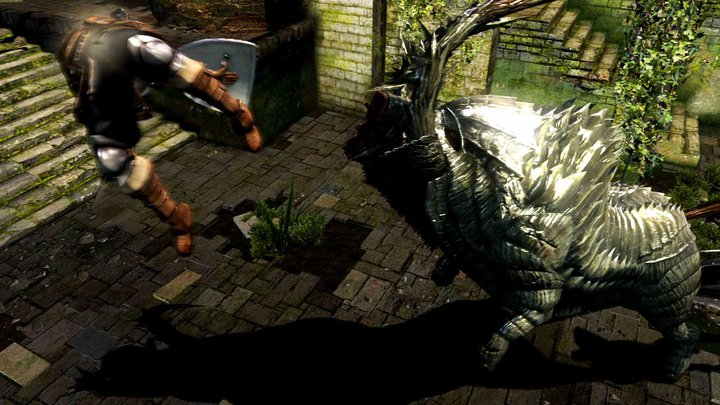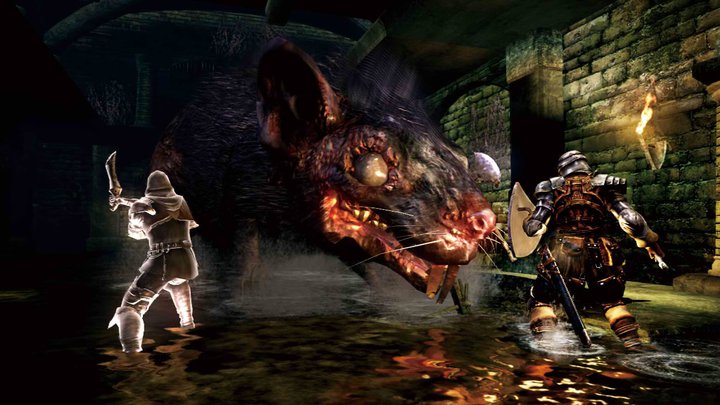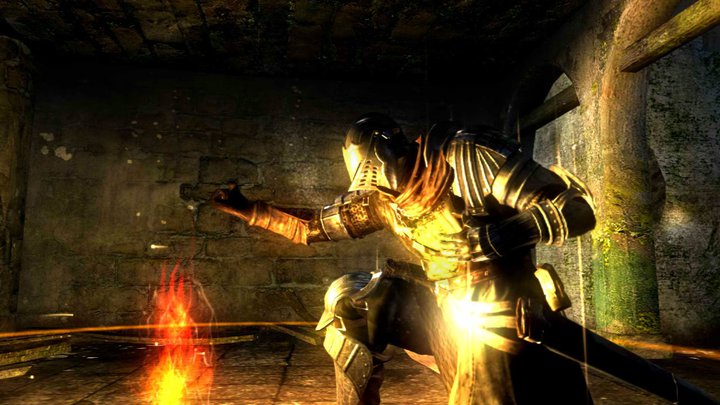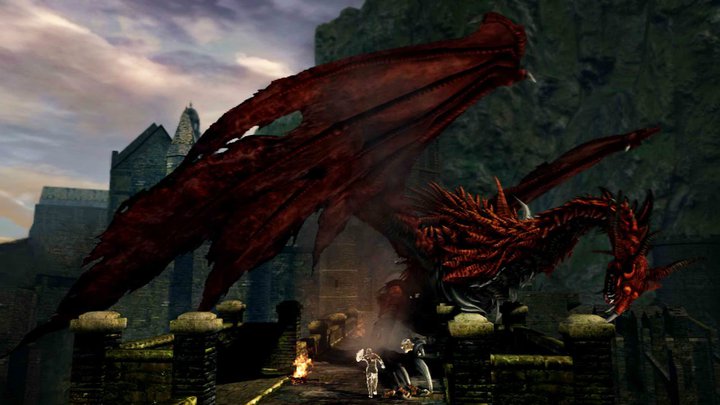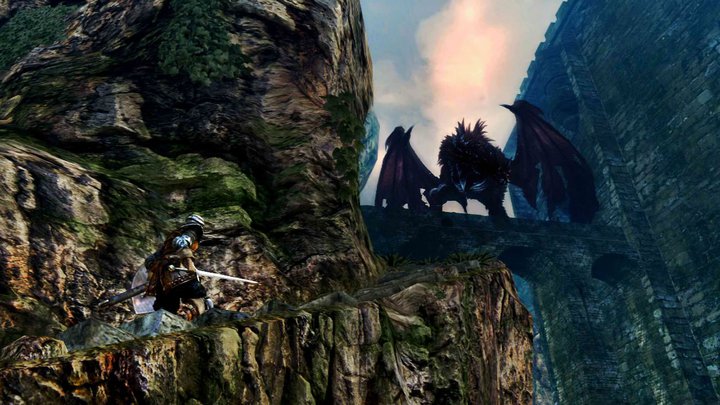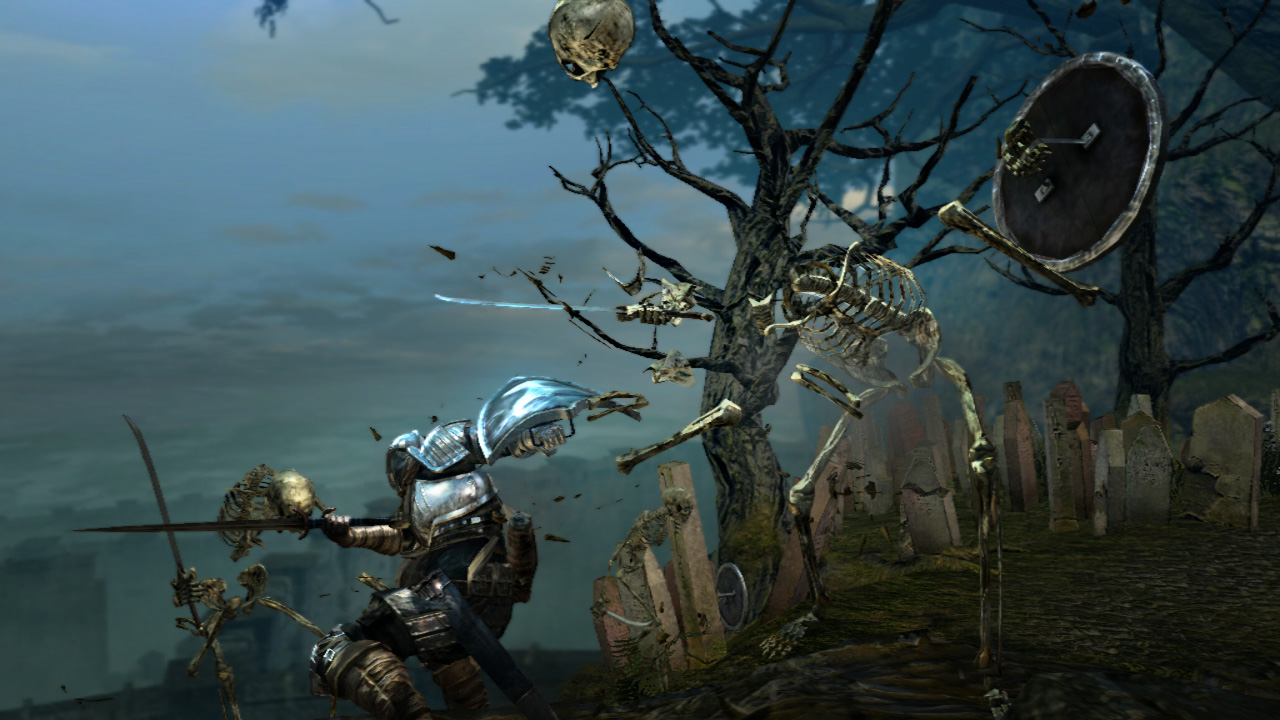With one arrow left, a short sword, and a battered shield, I run around the short ledges of a hidden path under a giant bridge. I can hear the angered breathing of the red drake above me, its tail wagging low and down. I am safe for the moment. Turning a corner, I tear through some giant rats and climb a ladder, the top of which is guarded by an angry skeleton with a sword. Dodge. Parry. Strike. The skeleton crumbles. I look through the arched portal in front of me. A fully armored bull with red eyes glares back from atop an incline. I loose my arrow. It does nothing but gather the demon’s attention, and it charges. My only option is to dive into the area. His charge misses, but alas, I am struck anyway. Two archers stand perched above, raining arrows. Putting my shield up, I turn to the right and am face to face with another skeleton with a pole arm. I dodge his blow only to land directly in front of the bull. He charges. I die.
Welcome to Dark Souls.
FromSoftware in 2009 gave the gaming world something it seemingly hadn’t seen in a while: a hard game. It was a game that said, “No, learn from your mistakes, stupid,” and it never cared how you felt about it. That game was Demon’s Souls, and it was GREAT. A couple of years later, and we have Dark Souls, a spiritual successor in this realm of no-holds-barred, stupidly difficult gaming. Does it hold up? Or was Demon’s Souls a one trick pony?
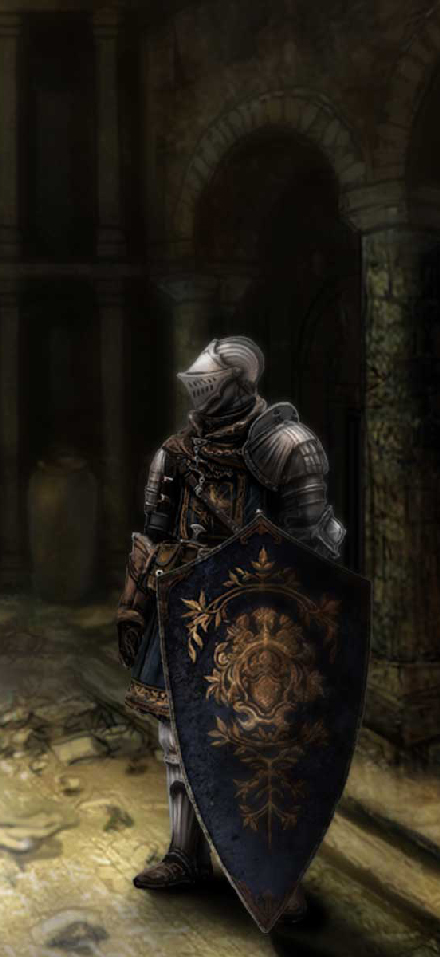
Equip Yourself
Let’s just get into the heart of the matter. Dark Souls plays just like its older brother Demon’s Souls. If you are unfamiliar with that, this Action/RPG is played at a slow pace, with great detail afforded to methods of striking enemies and blocking. The shoulder buttons are used to manage your right and left arms with normal and strong attacks, with the face buttons mapped to dodging and using items. Your arsenal consists of myriad weapons: swords, greatswords, halberds, spears, axes, greataxes, bows, daggers, clubs, spells, and shields. These are broken down even further. Swords, for example, come in all sizes and do different effects based on whether they are thrusting or slicing, say. Many of the weapons have unique swinging animations and speeds, and there is definitely a stretch of time where you will experiment with them to find what works for you. Knowing when to use certain weapons is essential, although this knowledge is mostly gained from experimentation. Just as important is a good defense, and equipping a good shield is mandatory. They come in all different sizes, but you are a fool if you don’t have one at the ready at all times.
Your ability to carry equipment is based on your character’s Endurance, which ties directly to your stamina and carry weight. To be able to swing that giant, cool looking sword, you will have to make sure that you are not equipping more than half of your carry weight. At least, if you want to swing it effectively. Keeping your equip load below half is key to an effective offense and defense, as your character will simply not move quick enough to survive very long.
As far as stamina, each swing of a sword, block of a shield, or whether or not you are running affects a stamina bar that drains until you no longer are able to make an effective attack or dodge. The gauge will refill after a second, but that second or so that you cannot block effectively can be devastating. Learning how many swings of your sword you can do before you run out of stamina becomes integral.
Each undead character or demon you kill gives you souls, which is used as currency for all things in the game. Leveling stats consumes these souls, as does buying items from merchants and upgrading equipment. You want souls, and you want a lot of them, but your current stock will be lost as soon as you die. And you will die a lot.
New to Dark Souls is Humanity, an item that when consumed gives you bonuses to resistance and item drop rate, but it also can be used to return to a human form (so you can invade others’ games or summon help) and to kindle fires. A counter at the top of the screen shows how many Humanity items you have used currently. Humanity is a fairly rare resource and can be lost upon death like souls, so there is definitely an extra risk/reward element to them when exploring with several points of Humanity on your person.
[youtube http://www.youtube.com/watch?v=9IbPrk-yuts&w=800]
On Your Toes
When you read about a player having white knuckles as a result of gripping the controller so hard, it is usually associated with a racing title, not a slow, deliberate title like Dark Souls. Where in the racing game, these knuckles blanco come from high speed, near death power-slides and near misses. In Dark Souls, clutching the controller and turning your hands into claws result from “Holy crap I can hear a thing around that corner and I have 30,000 souls on me and it could kill me and I am low on health and AHHHHHHH!” This happens a lot.
The moments at which your character is safe and you as a player feel that your character is safe seem fleeting. Scattered throughout the game’s world are bonfires, and you use these to save and manage your inventory. Only while resting against a bonfire is your character truly safe. Everywhere else, good luck. There is no Pause in the game. Pressing the button will bring up a menu, but everything around you is still happening. Monsters don’t give a flip if you need to change the brightness. They will also follow you to the nearest merchant, and starting up a conversation just means you are vulnerable.
Being stressed in Dark Souls is actually a big learning tool that one might not realize at first. It serves to slow you down and make you think, and that is vital. Above almost all else, patience is the key to this game. Assessing a situation, and figuring out a plan is just as crucial as having good gear and stats. In fact, stats are not as important as you might think. There are people playing through the game and deliberately not leveling for the challenge of it. And it can be done.
Yeah, but I Heard the Game is Hard!
Dark Souls has a reputation of being an incredibly difficult game, and while it certainly is tough, it definitely isn’t insurmountable. The game skirts a balance between being cheap and rewarding, and I have a feeling the amount of patience you are able bring in to the experience tips the scale one way or the other. The game is really only unforgiving in that it expects you to learn and then apply your new knowledge without handing anything out for free. Sure, that monster might hit you once and kill you, and that might at first feel cheap as all get-out. But on your return, if you brought that thing you just learned along with a bit of patience, you will hopefully figure out that monster’s attacks, dodge or block them effectively, and win. It might take a few tries. Then you will turn the corner and die from the next thing. Such is life!
When compared directly, Dark Souls probably the easier of the two between it and Demon’s Souls. This is largely due to your Estus Flask, a health item that you fill up each time at a bonfire. At most bonfires, the flask fills up with five uses, but you can kindle the flame up to ten uses (and later up to 20). It’s free health, and although it doesn’t fill up your bar fully with each swig, having ten sips of health per outing is not too bad. Now, it takes your character some time to use this item, and you’ll be vulnerable the entire time, so it doen’t take all of the danger out of the game. You still have to find a good spot to heal, especially in boss battles, and a healing strategy will be one you subconsciously add to your play style. Still, in this game I always had more health and access to health than in Demon’s Souls, and I think overall that made it less difficult. Having played through Demon’s Souls probably helped as well, as the general gameplay is largely the same.
That said, I am in no way going to sit here and say that this game is easy. On more than one boss I spent over a dozen tries developing a strategy to defeat it, and then more figuring out if that strategy is sound before felling the foe. Sometimes that strategy simply meant gaining a level or two, but mostly it fell back on patience with a heavy dosage of watching and learning.
And there lies why people love this game: after hitting brick wall after brick wall and feeling like you cannot go any further, you figure out how to beat the boss or you successfully navigate a series of traps and enemies. Then a rush of achievement fills your body, and it feels amazing. And that feeling is amplified because for the last few minutes of that boss fight or challenging enemy, your heart was racing and the adrenaline was flowing. More so than many other games, Dark Souls radiates feelings of achievement, and for me, at least, the end of a particularly tough boss fight will have me shouting in happiness and putting the controller down for a moment to catch my breath. It’s great and it’s rewarding as heck.
Prologue
In the Age of Ancients,
The world was unformed, shrouded by fog
A land of grey crags, archtrees, and everlasting dragons
But then there was Fire
And with Fire came Disparity. Heat and cold, life and death, and of course.. Light and Dark.
Then, from the Dark, They came
And found the Souls of Lords within the flame.
Nito, the first of the dead
The Witch of Izalith, and her daughters of chaos
Gwyn, the Lord of Sunlight, and his faithful knights
And the furtive pygmy, so easily forgotten
With the Strength of Lords, they challenged the dragons.
Gwyn’s mighty bolts peeled apart their stone scales
The witches weaved great firestorms
Nito unleashed a miasma of death and disease
And Seath the Scaleless betrayed his own, and the dragons were no more
Thus began the Age of Fire
But soon, the flames will fade, and only Dark will remain
Even now, there are only embers, and man sees not light, but only endless nights
And amongst the living are seen, carriers of the accursed Darksign.
You Are Undead
One of the best and worst aspects of Dark Souls is its story. The game, like Demon’s Souls takes a minimalistic approach to explanations that extends to its story. On your left you will see what the game gives the player when first turned on. Beyond these fairly cryptic words, it’s up to you to just figure it all out. And that is not a bad thing, really, but it can be a bit frustrating if you happen to want to know why things are. I would love to know more about some of the areas in the game, but you are mostly forced to simply infer.
Fortunately, inferring becomes part of the fun. You will speak with a few characters here and there that will provide bits and pieces of backstory, but mostly you gain knowledge of this land through its architecture and snippets from item descriptions. If you have ever played Shadow of the Colossus, this idea will not be foreign to you. Mostly, though, the story remains pretty elusive unless you want to dig.
That the game can keep its story from me and still be wholly engrossing is a testament to its gameplay and atmosphere, and in the end makes me like the game even more.
Look at That Castle
Speaking of atmosphere, let’s talk about atmosphere. I do not know if atmosphere can drip, but if it can, Dark Souls leaking the gooeyest atmosphere this side of, well, Demon’s Souls. As fantasy titles go, you really cannot get any better than the offerings served up here. As a bonus, this decayed and broken and shiny and messy and disgusting atmosphere is all beautifully rendered, and if you don’t stop every once in a while to appreciate that, then I don’t know what to tell you.
Unlike Demon’s Souls, where areas of the game were broken up into large levels, the world here is all connected, and it all feels connected, which is just as important. There is a scale to the world that feels like it is 1:1 with your character, and it is very impressive. Structures feel big because they are big, but they also look “normal” because that’s just how large they would need to be to fit the size of a human. In more open areas, you might see a castle in the distance that looks like neat window dressing to the scene you are in until later on you realize you are in that castle and that by looking out a window you can see the original area in the distance. And there isn’t some quick method of spanning these distances. You walked and fought to get there, and it felt like it. The first time I really noticed this was when climbing a tower in an area called Sen’s Fortress. I had finally made it to the roof, and over the horizon I spied the roof and domed tower where I fought a pretty notorious duo of bosses. The second time was upon entering the city of Anor Londo. If you’ve been there, you know. There’s a reason why one of the notes you can leave for other players is “Gorgeous View” and why you will see that note left in dozens of places in the game.
Anor Londo
You'd be surprised at how much of this place you get to explore.
The interconnectedness of the game continued to impress me throughout. That might seem like a strange thing to be impressed about (of course areas of a game are connected to other areas of a game!), but it is in the way areas are presented that make it impressive. For example, a highly tred bonfire in the game is at “the end” of the Undead Parish area. Through the immediate door in the room is a long bridge heading towards Sen’s Fortress. The first time you make this journey, you’ll notice the coming fortress but maybe also the deep green trees on either side of the bridge. Later, going down some stairs from that same bonfire, you will finally defeat a pretty tough monster that leads to a dark forested area. This new area obviously begins right under that bridge in those unassuming trees. Further on in the forest, you can find a shortcut back up towards the starting area of the game, and its position makes sense relative to other areas. In another example, after completing an area that is at the lowest point – vertically – in the game, I was cautiously making my way through some dark caves when I looked over a ledge to see far, far below that very area I had just beaten. The way all of these places are jammed right next to each other is just really cool, and given that there are no load times as you traipse around (unless you die or warp) makes the world seem that much more alive, although everything within is kind of undead.
We wouldn’t be able to discuss the beauty of the game without talking about its score, or lack thereof. Only during certain situations – mainly boss battles – does Dark Souls offer up a soundtrack. The rest of the game sits in musical silence. You will hear naught but footsteps and the environment for the majority of the experience, but this simply keeps the player focused on all of the things that want them dead. Some footsteps or a scraping that you cannot immediately place is far more damning to your psyche than trilling strings. And in those instances where music does surface, the impact is much greater than it otherwise would have been.
Phantoms
The online system for this game has been expanded some, but not to the point where you will be playing Co-op with friends. Like Demon’s Souls, certain items allow you to join others’ games, whether to help or to hinder. You can also leave hints on the ground that will show up in others’ worlds, and if your notes get rated positively, you gain humanity.
New to Dark Souls are covenants, factions in the game you can join where you can gain items by doing certain tasks. These covenants bind your character to them, and only by certain means can you safely stop being a part of the group. For example, if you break one covenant to join another, the first will become hostile to you, and depending on the covenant this will mean different things. You will also be placed in the Book of the Guilty, an item that is purchasable by players. One particular covenant’s goals are to hunt down those in the book, and if you choose that covenant you can use the book to see whose games you can invade and torment. Most of the covenants have a PvP/online angle to them, and by completing goals set by the covenant leader you can rank up in the covenant to gain items or weapons and armor.
Personally, I did not do much with covenants in my play through so I cannot speak to whether or not they make the game better or worse, but they certainly are an interesting addition that gives players extra incentive to utilize online features.
Dark Beefs
For everything that is right with Dark Souls, there are a couple of areas that could use some improvement. The first is essentially a nick-picking issue with frame rates. Most of the game, the rates are solid (PS3 version is what I played), but in a couple of areas, the environments are just too big, and the game struggled to keep up. Normally, this wouldn’t be too bad because the game itself is not a fast paced one, but the particular area where it was the worst happened to be a poison swamp where any wading was bad news. Not a huge deal, but certainly frustrating when battling fire breathing crag-spiders and giant mosquitos while the game chugs.
The only other issue comes in the menus, which are generally just not really that great. You can see the items that you have, and that’s nice. And it works, technically, but later on in the game when you have picked up several dropped weapons and armor, your lists become filled with junk. You can offload them into a storage box, but there is no penalty for carrying large quantities of things, just equipping items. Instead of showing ten Short Sword Hilts individually, why not show one entry with “x 10” next to it? More frustrating, when upgrading weapons or armor, the things you have equipped are down somewhere in the mix on your large list. I pined for your current armor to be displayed at the top of the list so you wouldn’t have to spend so much time looking about for them. Again, not a terrible tragedy, but some better usability would be nice.
Should You Prepare to Die?
I was a pretty huge Demon’s Souls fan when it came out a few years ago, and Dark Souls simply takes everything Demon’s did and made it better. I am not really a fan of the item management for either game, and the story is not something that will be really that self evident. These minor things, however, cannot mar an otherwise spectacular title for those who have the patience to get through it.
Dark Souls II was recently announced, too, so that should give you some incentive to pick this title up. Do it.
